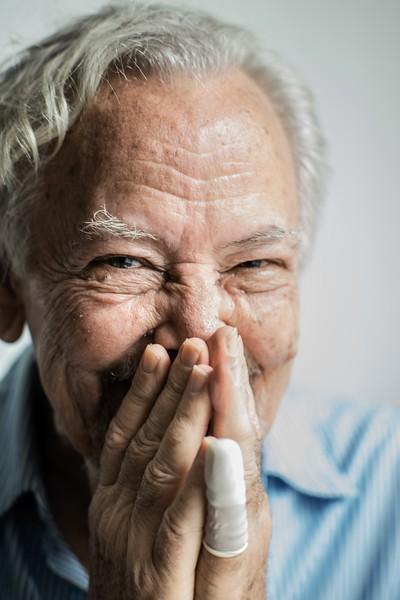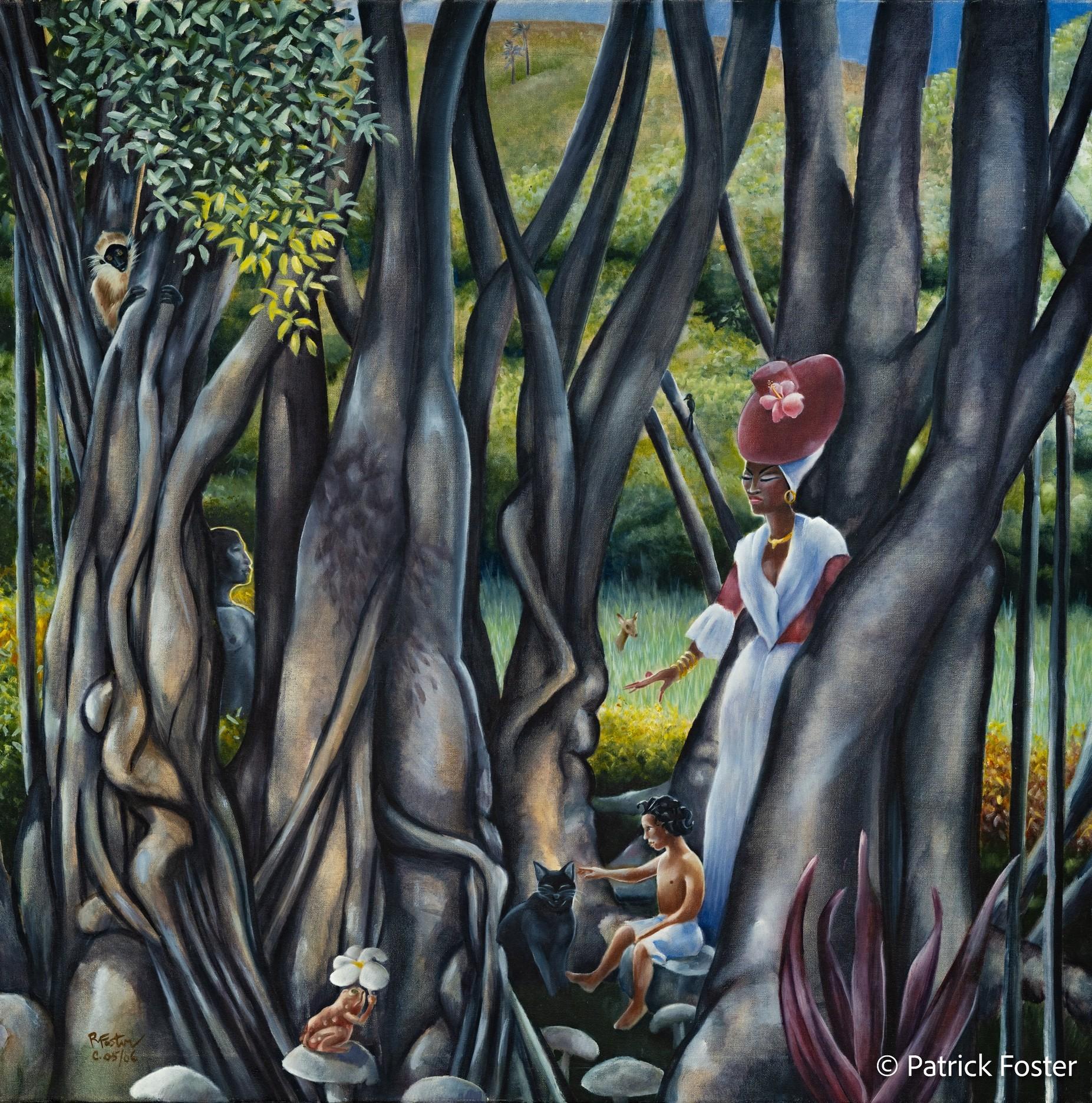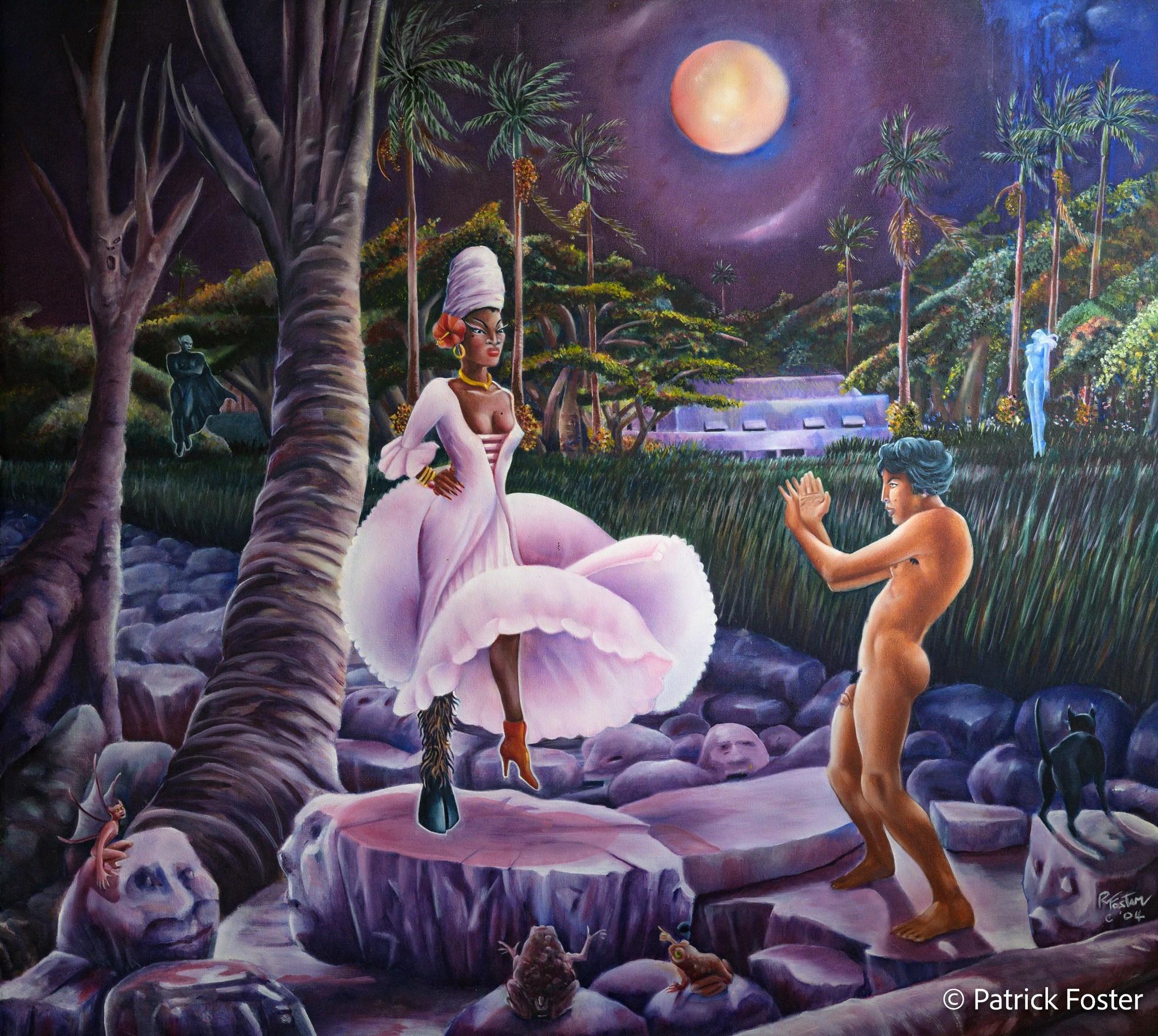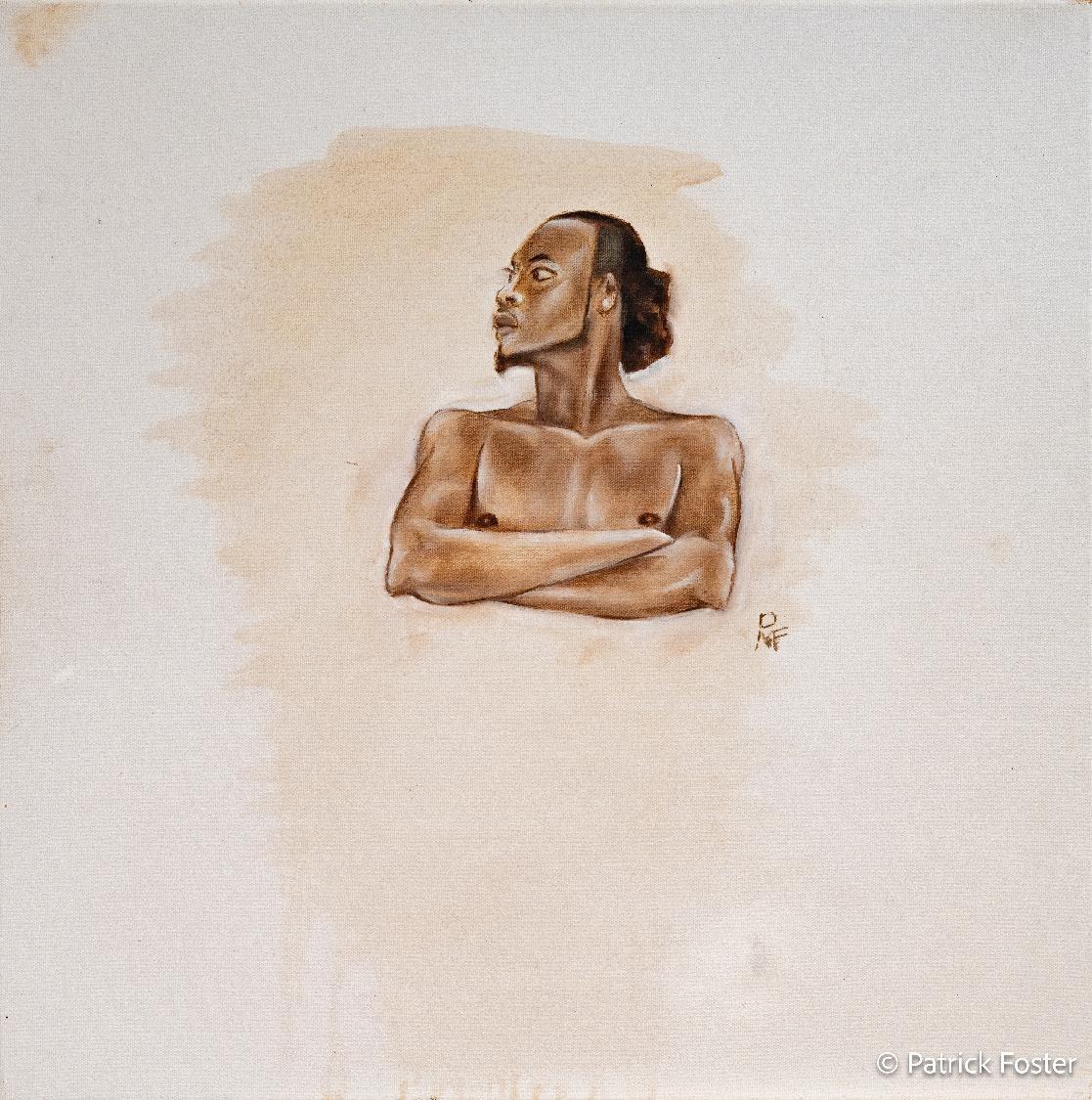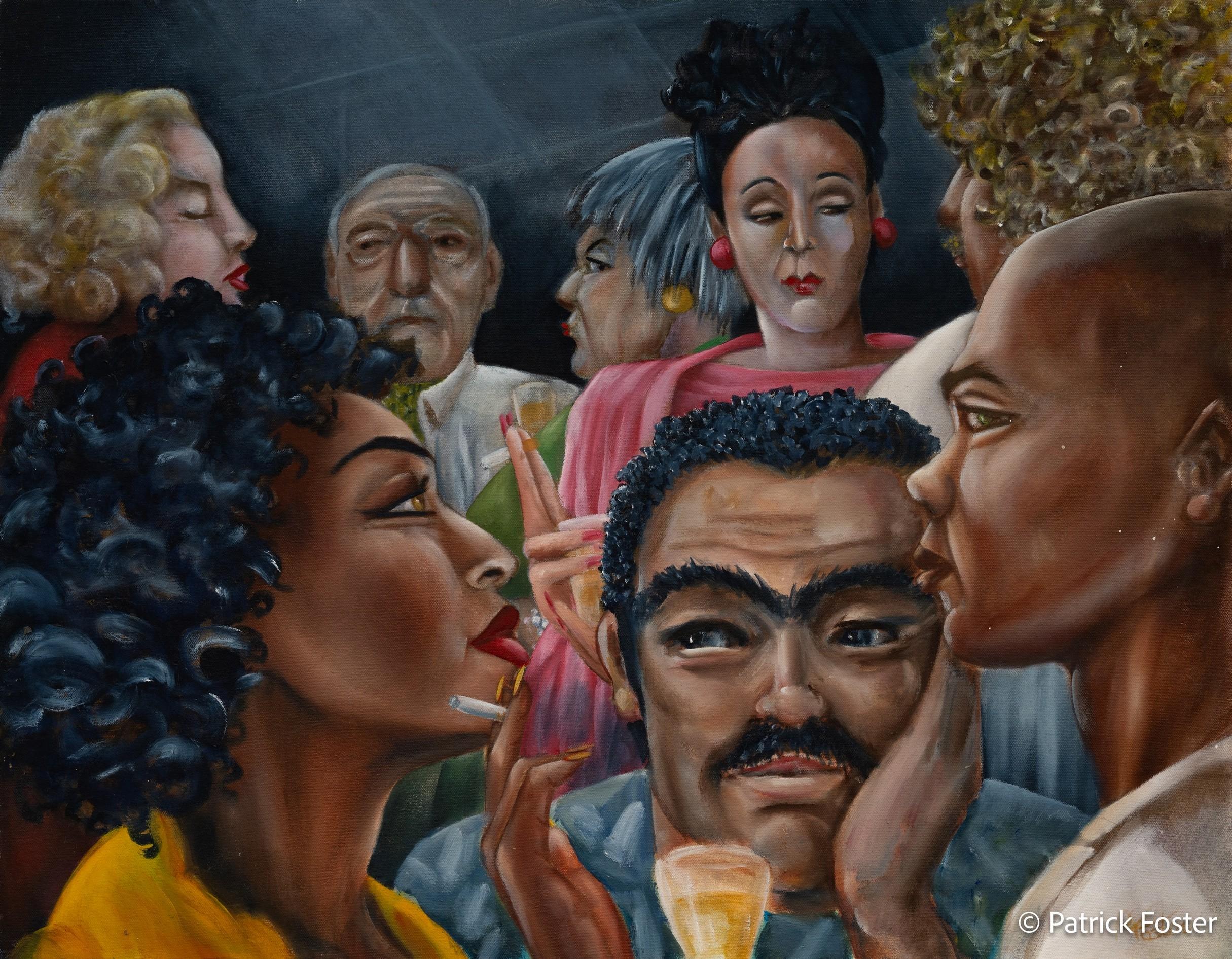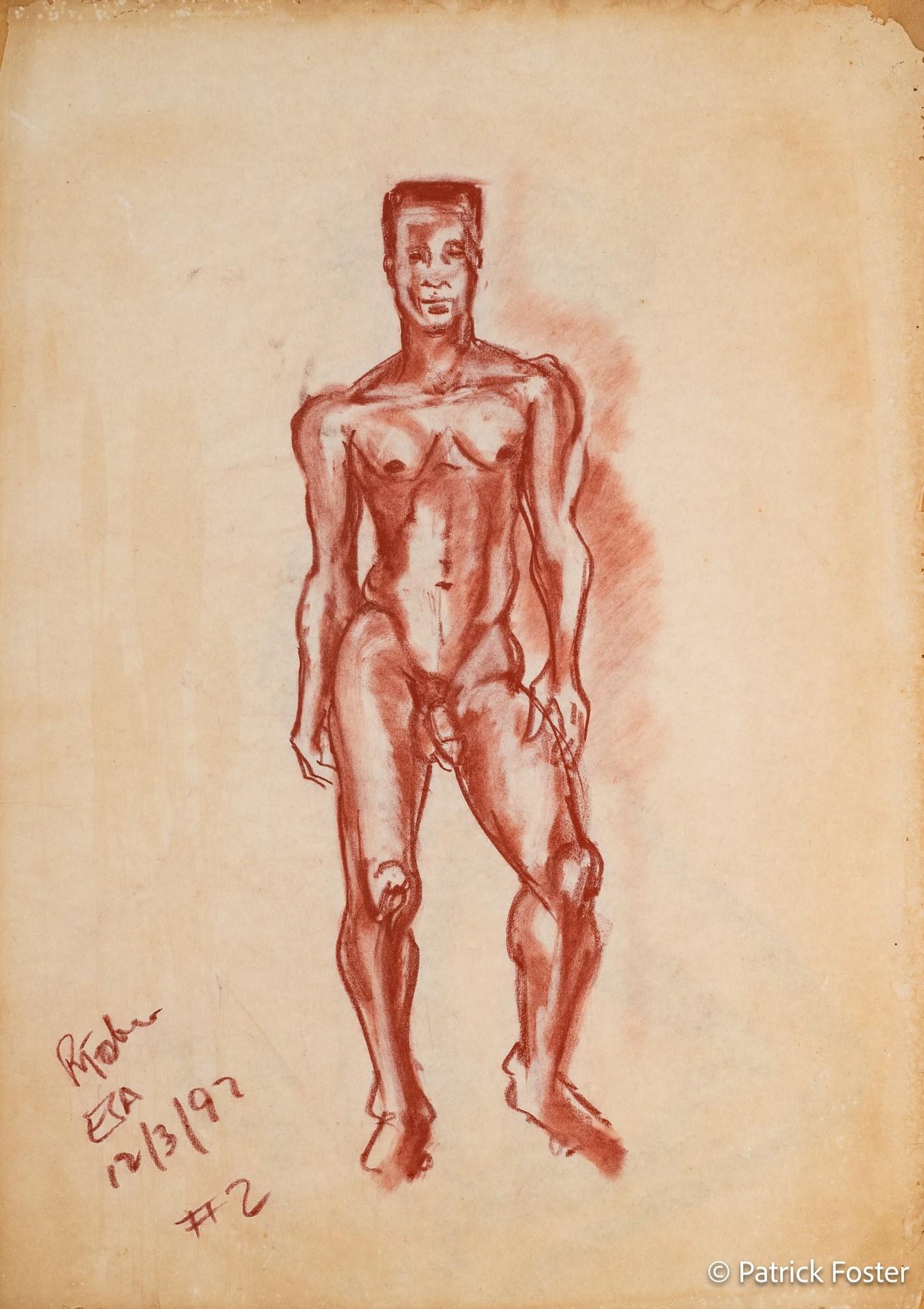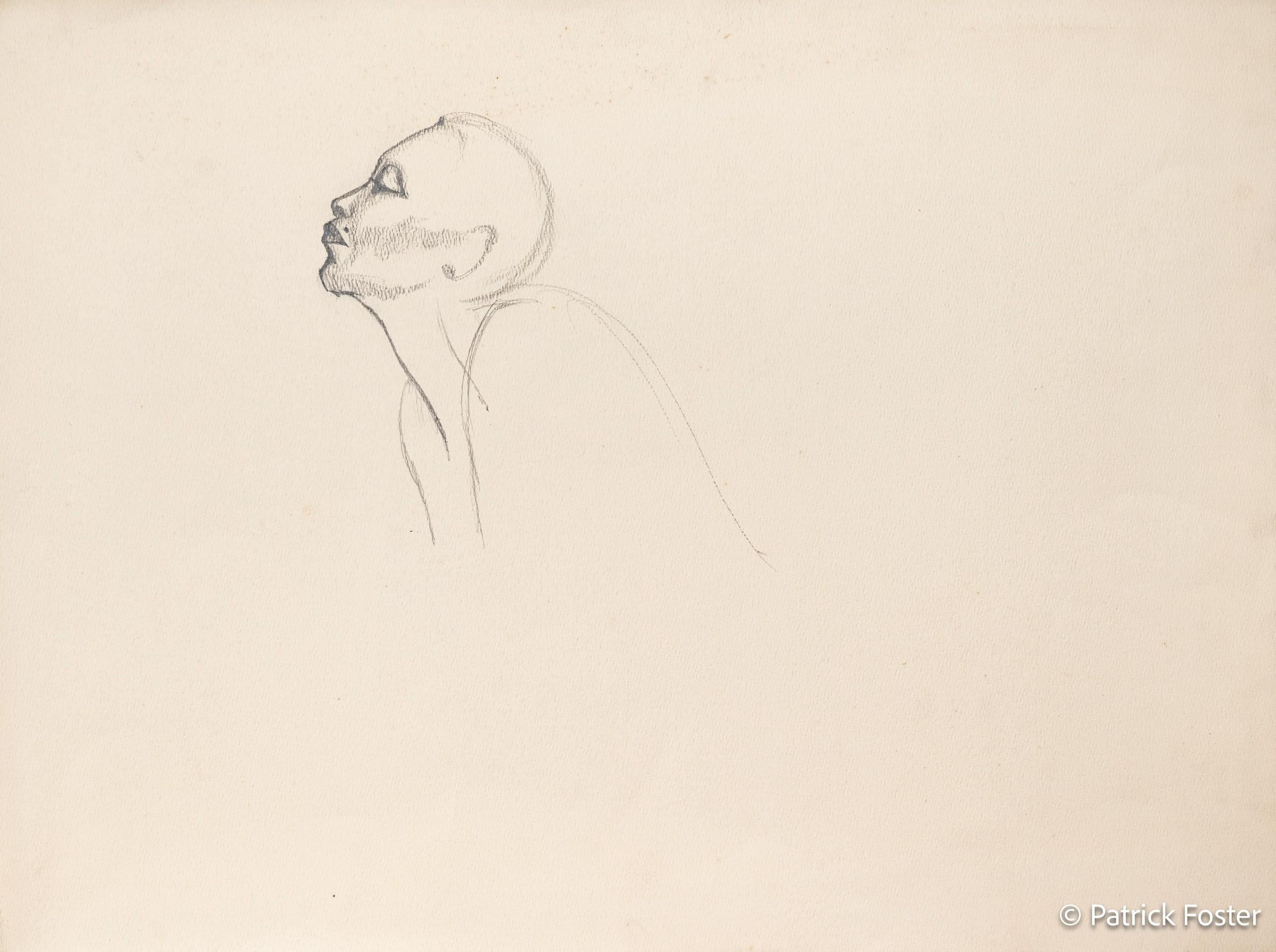PATRICK FOSTER 2025
Words and Images
by Risée Chaderton-Charles eye.one.visuals
Patrick Michael Foster
There is an awkwardness of teenagers.
It is a gangliness that is not only about the inability to control too-long limbs and too-big feet; it extends to tooloud voices and poor decisions. Random inner thoughts can flare into wild musings that find their way to the tongue without being sensibly leashed by the brain.
It was at this stage of my young adult awkwardness that I first met Patrick Foster.
He had just been photographed and I, a lowly assistant, had awkwardly mispronounced his name. As the crew got together for a group shot he leaned into me and said quietly, in his husky voice — for just me to hear — “Its Patrick, darling.”
This small moment was something that I had rarely seen then, and have seen too rarely since; an ignorant, erring underling corrected by a star not with irritation, but with grace, kindness, and love.
This was the shining moment that I fell in love with Patrick Foster, and my affection and admiration for him have not faltered in the decades since.
Patrick has always filled any room he has been in. Even when he has not tried or even wanted to do so, it is impossible to miss those mischievous blue eyes, that sharp wit, and that eyebrow that often quirks with unspoken revelry that only his friends know in depth. His world lives in vivid colour in his head, carried along, painted, repainted, sometimes with the intensity of oils and at other times with the dreamy shades of watercolour. Every memory of his first homeland is a beam in the supporting scaffolding of his ongoing life.If you are lucky enough to sit with Patrick in his quiet times, you may be gifted with stories of his childhood in Guyana; of memories of his mother, of his brother Simon — whose presence will never not be missed — and of the folklore that was an integral part of many Caribbean childhoods.
You may also hear him tell of the pain of being Caribbean white but not feeling or acting white in the Caribbean; of yearning for casual belonging in spaces where his skin made him stand out as a man of potential status, and a barely-trusted ally at best.
In his youth Patrick made an attempt to fit in where he had long been told he belonged — in Europe. It was a poor fit, a jacket not only not tailored for him but also constructed roughly and of coarse cloth. Blinking back tears he recalls an incident on his return to England from holiday in the Caribbean, skin ever so slightly burnished by tropical heat and warm Caribbean sun, where a white acquaintance describes him to another acquaintance with a racial slur “I told you he was a ‘wog”.
After that, returning to the Caribbean was a non-negotiable. Despite those who would try to deny him, Patrick knew then that whatever obstacles he faced here, no matter how many fights he was going to have with Caribbean people about his right to be, to see, to be seen, to create Caribbean art, these people, these Caribbean people were his and he was theirs. Family may fight but they are family, and in that single moment in England Patrick became very aware that his family was not only with those to whom he was related by blood but more broadly among the people of the Caribbean. He is ours and we are his.
Also, like most Caribbean people, he’s not much for the cold. Decades later, his work continues to reflect that truth, from fighting with senior management at advertising agencies for the right to have darker-skinned models in local advertisements, to designing costumes that reflect a deep knowledge and love for Caribbean history, to writing plays that examine our past with a critical lens, to his persistent love affair with figures from our Caribbean folklore. With the goddess Mama Glo whose story evolves every time she flows from his brush. Patrick consistently plucks at the raw innards of Caribbean life. He papers it thinly with bright colours, but always leaves enough for those family members—even those who still want to fight— to know that these stories are not only Patrick’s stories but that, like him, they belong to all of us.
THE ARTIST
RACHEL
2012 Oil on Canvas 12"x16" $710
PAPA BOIS + MAMA GLO ABOVE INTERIOR
Oil on Canvas 32x32 $4,430
2020 Oil on Canvas 20” x 20” $1,570
LEGEND
2022 Oil on Canvas 14” x 18” $1,000
LA DJABLES AND BOYCHILD AT PORTAL TO INTERIOR
BLACKBIRD
MAMA GLO’S GROVE
2005 Oil on Canvas 18"x24" $2,000
NFS From the Private Collection of Sarah Venable
MAMA GLO IN HEADDRESS
2004 Oil on Canvas 22"x28"
MAMA GLO MESSENGER
2010 Oil on Canvas 22"x28"
NFS From the Private Collection of Sarah Venable
DJABLES AND YOUNG MAN ON STONEDEAF PATH
NFS From the Private Collection of Thelma Bortolotti
2004 Oil on Canvas 36"x40“
AGE OF COPPER AKA “ I WANT TO BE PAINTED LIKE THAT”
2018 Oil on Canvas 32"x"32 $3,570
DOROTHY’S FRIEND AT MAD DOG HOUR
x 36”
MEDITATION EAST
Oil on Canvas 18"x24" $2,140
OTHELLO 1990 Oil on Canvas 30"x30“ $5,000
M M MYTH
1991 Oil on Canvas 36"x36" $4,430
READING RAYMOND CHANDLER
Oil on Canvas 24"x30" $3,140
LIFE STILL aka INDIGO NUDE
2009 Oil on Canvas 32"x36" $5,290
SITTING
2013 Oil on Canvas 24"x24“ $3,140
SOULCASE I
2011 Oil on Canvas 24"x24" $2,570
SERIOUS SOULCASE II
2011 Oil on Canvas 8"x10“ $430
SERIOUS SOULCASE III
2011 Oil on Canvas 8"x10“ $430
CINEMA
1985 Coloured Pencil 22.5"x30.5" $2,000
SLICE OF LIFE
2021 Oil on Canvas 12"x16" $710
GREEN DREAMS
2016 Oil on Canvas 18"x18" $1,290
EVERTON Oil on Canvas 12” x 15.75 $570
STILL
Oil on Canvas
$570
2024 Oil on canvas 20"x20“ $860
ANOTHER COCKTAIL
1991 Oil on Canvas 22"x28" $2,140
The Legendary Patrick Foster
by Sarah Venable
Actor, director, playwright, painter and author, Patrick Michael Foster is one of Barbados’ creative treasures and a man of hidden depths.
These days, he’s holed up in his studio. There are brushes sticking out of jars and the aroma of turpentine wafting through an ample 19th century space dotted with memorabilia. A theatre photo shows Patrick as a beautiful young man. Propped up against the walls are some paintings he’s retained, where birds, panthers, Caribbean folktale creatures and snakes inhabit lush landscapes. You know something intense is going on, but what? “They express Caribbean identities and archetypes,” Patrick explains. “They appear in folklore, but I call them Legends.”
Born in Guyana in 1942 and sent to a Jesuit school in Trinidad, Patrick was uprooted again for his last leg of education in England, where he went on to train as an actor at East 15 Acting School. By the mid 70s he had worked on stage, found buyers for his visual artwork, and had a play he’d written performed on BBC-TV. Career options were promising, but he felt out of place. “The main thing I learned in England was that I wasn’t English. It’s my language, but not my culture. I’m Caribbean, and the legends called me to come home.”
He landed in Barbados totally without prospects. Only one of his four siblings was here— Simon, a well-known fashion designer. Doors started opening when Patrick met the celebrated British stage and screen designer, Oliver Messel. Moving easily between glamour and grit, Messel introduced the young creative to both the star-studded west coast set and to the local theatrical community. It was among the latter that Patrick would flourish.
Meanwhile, Patrick’s cultured voice made him a natural for radio. He created a 3-hour talk and entertainment show on VOB called “Bim, Bam, Bim!” which won him Barbados’ top awards for best producer and best broadcaster.
His early years of return also included being creative director at an ad agency. It was lucrative but unfulfilling, so once again he leapt into the void that is so often the artist’s lot.
Luckily, the Green Room Players commissioned a play from him. Patrick had just met a kindred spirit, the legendary Barbadian author, poet, literary editor, stage performer and painter, Frank Collymore. Patrick’s Green Room play would celebrate his life and achievements. Over the next few decades, Patrick scripted six more plays and acted in and directed several more. “I was part of the revolution of theatre here,” he said. But that’s another story.
As an actor, his most widely seen role may be his 2017 portrayal of Puck as an aging queen butler in writerdirector Shakirah Bourne’s film, A Caribbean Dream, which sublimely translated Midsummer Night’s madness into Cropover confusion. You can also see him in Menelik Shabazz’s Heat.
Nobel laureate Derek Walcott so liked Patrick’s performance in his two-hander, Pantomime, that he wrote him a role as a priest in a subsequent version of Ti Jean and His Brothers. Sir Hillary Beckles, Vice Chancellor of UWI and chairman of the CARICOM Reparations Committee, also wrote Patrick into all of his plays concerning the linked legacies of slavery and colonialism. And then there’s the always-lively Gap Theatre, for whom Patrick has written, directed and performed.
Creating characters is Patrick’s constant through-line, with each art form nourishing the others. He has nearly finished writing a sprawling novel (Blood and Soul) featuring the same Caribbean Legends that appear in so many of his paintings. The work appears to reveal their hidden lives, but at heart the writing is deeply personal. It’s about coming home, both to a place and to the self, just as their creator has done.
NEW YORK, NEW YORK
1984 Coloured Pencil 22.5"x30.5" $1,570
THE FRENCH WOMAN AND HER SON
Oil on Canvas
(Process)
UNTITLED
Pencil 12"x18" $570
EVERTON SKETCH 1989 Pencil 19.5"x24“ $1,000
RICHILD
Pencil 12"x17.75" $430
RICHILD’S LINE
Pencil 12"x18“ $430
RICHILD IN RED
Coloured Pencil 12"x18" $430
SPRINGS AS MIDNITE
1981 Coloured Pencil 12"x17.75" $430
RICHILD SPRINGER PROFILE
Pencil 18” x 24” $430
SELF PORTRAIT
DISCO SINGER
Pencil 18"x24" $1,290
NY’84
Pencil 18"x24“ $1,290
UNFINISHED
Pen and Ink 14"x22" $710
SKETCH- IMPROVISTAION TO DEBUSSY I 1989 Pencil 10.5"x18"
$290
ESA – LIFE 1990 Pencil 11"x14" $570
FRANC RECUPERATING…
1978 Pencil 17.75"x25.25 $1,000
DOROTHY’S BLUES
Pencil 11x5"x16.5" $430
Pen and Ink
10.5"X16.5“ $570
RAIN No 2
RAIN No 3 1992 Pastel on Newsprint 16.5"x23.25" $430
STELLA + STANLEY KOWALSKI
UNTITLED No 3
1990 Pencil 20"x26" $570
Curatorial Notes by Logan Thomas
Regarding the Exhibition
Patrick Foster Now: LifeLine at
The Queen’s Park Gallery, Bridgetown, Barbados
Jan 11, 2025 - Feb 6, 2025
Curator’s Notes
Regarding the exhibition Patrick Foster Now: LifeLine at The Queen’s Park Gallery Jan 11, 2025 - Feb 6, 2025
What follows is a guide to support the attendants at the Queen’s Park Gallery in fostering dialogue with visitors to the gallery. Given that much of Patrick Foster’s work is highly conceptual, when asked to explain his work he likes to paraphrase a quote by surrealist filmmaker Jean Cocteau, known for the film “La Belle et La Bête”, 1946.
“Asking an artist to speak about his work is like asking a plant to discuss horticulture.”
In that spirit it’s important to maintain a certain aura of mystery around the work by asking questions instead of providing informational statements. Since much of Patrick’s work can be said to reframe characters and personalities from Caribbean folklore and international culture, perhaps no better homage can be given than to allow the viewer to rely on their inner responses to the work.
Below is a list of observations that may assist:
• Patrick Foster prefers wherever possible to draw and paint from life, rather than from photographs. This meant regular meetings with models who became true collaborators in his work. Notably in this exhibition: Everton Alleyne & Shannon Arthur.
• "Blood & Soul” entered as “It is Written, Book 1” an unpublished novel written by Patrick has been selected as one of the finalists for the 27th Frank Collymore Literary Endowment, where the awards ceremony takes place on Saturday, January 11, 2025 - the same night as the exhibition opening. This book, once published (sponsorship is being sought) will take readers on a journey into the ‘interior’. Into the jungle, into the heart.
• Viewers who might be familiar with Foster’s recent plays "Don Put Yuh Head Where Yuh Body Can’ Go” and 'Don' Put Yuh Head Where Yuh Body Can’ Go Tek 2’ (featuring the characters Papa Bois, La Djables and the actor Sal), can rely on themes presented in those plays as companions to his works on canvas and paper.
• LifeLine = OneLove. Foster when asked about the “Line” riffs in multiple directions. The lines of an actor, the lines a dancer might create with their movement, the lines of the body, the lines on the page. The lines that divide, and bring together. The line is alive, and it moves!
• Patrick’s interest in Marilyn Monroe is greater than an actor’s fascination with a popular actress or a pretty face. Whenever she comes up in conversation he speaks of her with great respect as a master of her craft. As a deft mind ahead of her time that both beguiled the world of popular culture, and bewildered those who were blinded by the glamour - projecting all of their own ideas and desires onto her, missing the point and forgetting to take her seriously.
• The Painting “Down The River Of No Return” borrows its composition from Édouard Manet’s, “Olympia”, 1863. A painting that might be familiar to those with a background in art history. An excerpt from Dr. Thomas Folland for the website “smarthistory” discussing the original showing of the painting in a Paris salon. Where viewers were incensed by the use of the nude figure to represent a real woman in a seemingly all too real situation. https://smarthistory.org/edouard-manet-olympia/ “It struck viewers—who flocked to see the painting—as a great insult to the academic tradition. And of course it was. One could say that the artist had thrown down a gauntlet. The subject was modern—maybe too modern, since it failed to properly elevate the woman’s nakedness to the lofty ideals of nudity found in art of antiquity —she was no goddess or mythological figure. As the art historian Eunice Lipton described it, Manet had “robbed,” the art historical genre of nudes of “their mythic scaffolding…”
Also of note is the inclusion, and interpretation of the Black woman in the background holding flowers. Which has been the subject of heated discussion for the last 160 years.
“…the painting’s inclusion of a Black woman tapped into the French colonialist mindset while providing a stark contrast for the whiteness of Olympia. The Black woman also served as a powerful emblem of … one of many fictions that aimed to justify colonial views of non-Western societies.”
It is important to appreciate how Foster has co-opted the layers of the conversation about this famous piece and used them to create this new work.
Where the figures Marilyn & the Roman God Mercury, a corollary of the Greek God Hermes (called the god of Commerce, Travellers, Trickery, Speed; Messenger of the gods & the guide to the underworld) are equals and both are engaging directly with the viewer.
• Regarding the title “Othello” the protagonist from a Shakespeare tragedy by the same name. He was a Christian Moor, a general of the armies of Venice. He was eloquent and physically powerful figure, respected by all those around him. In spite of his elevated status, he is nevertheless easy prey to insecurities because of his age, his life as a soldier, and his race. His ensign Iago uses this to twist his love for his wife, Desdemona, into a powerful and destructive jealousy.
• Patrick’s Artist statement is an excerpt from the poem by John Donne “Love’s mysteries in souls do grow, but yet the body is his book.” This quote may be a bit opaque for people who aren’t readers of 15th century poetry. The line appears in the context of a discussion about the relationship between the body and the soul, and discusses the interplay between spiritual connection and physical love.
• Viewers may notice the change in style over recent years where the most recent paintings “The Act” & “Presence” (Process) stand out both for their rendering and composition. The graces of age are perhaps one reason for the changes in rendering, but what about the simplicity of the composition?
• When Patrick is asked why he paints his subject material, his loudest answer is: “Because I Must.”
Possible questions to pose:
• In response to visitors asking about the use of nudity in a way that is more judgemental than curious - Is there something wrong with the human body?
• In response to visitors who appear more curious than judgemental about the use of nudity in the work - Do you think that nudity can be a metaphor for acceptance of self?
• Do you think drawing from photographs is better than drawing from life?
• What are some of the differences in experience between drawing from life, vs drawing from photographs?
• Patrick often uses the word “Soulcase” to refer to the body, what is meant by “Serious Soul Case”?
• What is represented by the mask in “Othello”, “Dear Brother” & “Full Frontal Male Nude With The Usual Suspects”?
• Are there any background figures in the artwork that stand out to you?
• Did you notice the faint outline of a profile in “Infinity”?
• Did you notice the white hat and dress next to the subject in “Improvisation to Debussy I”?
• Peter Minshall put it, in his poem “WHO AM I”, that he is a “Caribbean” - is it right for “Caribbeans” to recontextualize folklore characters, names, mythology from ‘outside’ to match our reality?
• Why aren’t Marilyn & Mercury looking at each other in “Down the River of No Return”?
• What do you think about Patrick’s use of foreground and background figures in his work?
• Regarding the painting “Rachel” Have you ever heard of Rachel Pringle? Do you know how she is typically been represented?
• Why do you think there’s a mirror in the corridor?
• What is the blackbird / black cat / butterfly?
• Why do you think the blackbird / black cat / butterfly appears in many of Patrick’s paintings?
• Do you think that folklore characters are still relevant?
• Are you familiar with Mama Glo, Papa Bois & Djables?
• What is OneLove?
• Patrick’s “Legends” exist in “Interior”. What is “interior”?
• Did you notice that Papa Bois, has the hooves of a deer, Mama Glo has the tail of a snake and Djables has a goat foot?
• Do you think the child is afraid of Djables? What about the young man?
• Who is the shadowed figure on the right side of "La Djablès And Boychild At Portal To Interior”? What about the deer?
• What do you think about the decision to create two separate spaces in the gallery?
• If you could use one word to describe the exhibition, which would you use
The NCF’s role revolves around the preservation of our cultural heritage and promotion of all forms of art and culture, both tangible and intangible through developmental and commercial programmes and products. The functional spectrum ranges from, generating cultural awareness at the grassroots level to promoting cultural exchanges at an international level. In its developmental role, the Foundation uses culture as a tool for national development, fostering and supporting the various art forms and new cultural products. In its commercial role, the Foundation is responsible for the promotion, production and hosting of cultural festivals and associated events.
A key part of this function now includes the responsibility for the staging and execution of major governmental and national events. In addition, as culture becomes more pivotal to national and international policy, the National Cultural Foundation continues to re-assess its responsibilities in light of all its functions.
The National Cultural Foundation Website https://ncf.bb/
PATRICK FOSTER NOW: LIFELINE
Published by Corrie Scott











